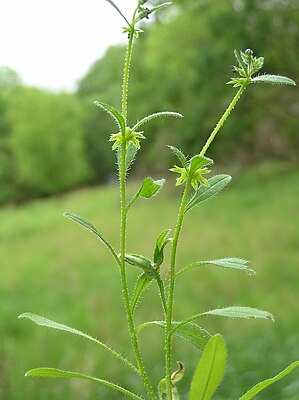Hives
| Hives | ||||||||||||
|---|---|---|---|---|---|---|---|---|---|---|---|---|

Hogweed ( Asperugo procumbens ) |
||||||||||||
| Systematics | ||||||||||||
|
||||||||||||
| Scientific name of the genus | ||||||||||||
| Asperugo | ||||||||||||
| L. | ||||||||||||
| Scientific name of the species | ||||||||||||
| Asperugo procumbens | ||||||||||||
| L. |
The asperugo ( Asperugo procumbens ), also down Lying asperugo or Schlangenäuglein called, is the only kind of plant genus Asperugo within the family of Borage Family (Boraginaceae).
description

Vegetative characteristics
The herb grows as a climbing to prostrate annual herbaceous plant . The aboveground parts of the plant are coarsely hairy. The up to 90 centimeters long, mostly unbranched stem is hollow and has five to six ribs. Of the simple foliage leaves distributed on the stalk , the lower ones are alternate, towards the top the leaves become smaller and almost opposite. The leaf margin is smooth or finely serrated.
Generative characteristics
The flowers stand individually or in groups in the leaf axils. There may be a short flower stalk. The relatively small flowers are fünfzählig double perianth (perianth). The five sepals are fused to below their middle. The approximately 1.6 millimeter wide calyx is somewhat regular, five-lobed and enlarges greatly to up to 8 millimeters until the fruit is ripe, with the calyx-lobes ending with two teeth. The five mostly blue to purple, rarely white petals are fused tubular. The corolla lobes are somewhat unequal. The five gullet scales are bumpy. The five stamens, like the stylus, usually do not protrude from the corolla tube. The stamens are very short and the anthers are elongated, relatively short at 0.6 millimeters. The 0.8 millimeter long stylus does not protrude beyond the corolla tube and ends in a head-shaped scar .
The four partial fruits of the Klausen fruit are upright, narrowly egg-shaped, almost flat, compressed on both sides and about 3 millimeters in size. It blooms and produces fruit in Central Europe from May to August, sometimes from April to November.
The number of chromosomes is 2n = 48.
ecology
The hogweed is a mesomorphic therophyte .
There is self-pollination and Velcro spread.
Occurrence
Asperugo procumbens is widespread in Eurasia and North Africa . It is a neophyte in some areas of the world, for example in the USA . In the German-speaking area, the species may only be native to Austria. In 1839 and 1980 it was only recorded in the NSG Max Schultze Steig in Germany .
In Austria, the hot herb occurs scattered in the Pannonian region , otherwise rarely. The occurrences extend to all federal states, in Upper Austria only inconsistent occurrences are known. In the area of the Alps and in the northern foothills of the Alps, the common herb is considered endangered.
The herb grows in Central Europe in storage communities under overhanging rocks, on paths and walls on warm, moderately dry, nutrient-rich and alkaline, mostly calcareous , mild, often low -humus, loose stony clay and loam soils . It's a nitrogen pointer . In Central Europe it is a type of character from the Sisymbrio-Asperuginetum from the Sisymbrion Association, but also occurs in other societies of this association or in those of the Onopordion Association.
Systematics
The valid first publication of the generic name Asperugo was made in 1753 by Carl von Linné in Species Plantarum , 1, p. 138 with the only species Asperugo procumbens L. Synonyms for Asperugo procumbens L. are: Asperugo alba Mazziari , Asperugo erecta I. Pop , Asperugo vulgaris Dum .Cours. , Asperugo vulgaris Bubani .
The genus Asperugo belongs to the tribe Asperugeaeae in the subfamily Boraginoideae within the family of Boraginaceae .
Common names
In the German-speaking countries, the other trivial names Deutscher Berufswart ( Tübingen ), Schlangenäuglein ( East Prussia ) and Teufelsleiter ( Hesse ) are or were used for this plant species, in some cases only regionally .
swell
literature
- Gelin Zhu, Harald Riedl, Rudolf V. Kamelin: Boraginaceae. : Asperugo , p. 414 - online with the same text as the printed work , In: Wu Zheng-yi, Peter H. Raven (Ed.): Flora of China. Volume 16: Gentianaceae through Boraginaceae , Science Press and Missouri Botanical Garden Press, Beijing and St. Louis 1995, ISBN 0-915279-33-9 . (Sections Description, Distribution and Systematics)
- Yasin J. Nasir: Boraginaceae. in Flora of Pakistan : Asperugo - Online. (Sections Description and Distribution)
Individual evidence
- ↑ a b c Asperugo procumbens L., snake eyes. In: FloraWeb.de.
- ^ A b Manfred A. Fischer, Karl Oswald, Wolfgang Adler: Excursion flora for Austria, Liechtenstein and South Tyrol . 3rd, improved edition. Province of Upper Austria, Biology Center of the Upper Austrian State Museums, Linz 2008, ISBN 978-3-85474-187-9 , p. 696 .
- ↑ a b Erich Oberdorfer : Plant-sociological excursion flora for Germany and neighboring areas . With the collaboration of Angelika Schwabe and Theo Müller. 8th, heavily revised and expanded edition. Eugen Ulmer, Stuttgart (Hohenheim) 2001, ISBN 3-8001-3131-5 , pp. 777 .
- ↑ a b Benito Valdés, 2011: Boraginaceae. : Asperugo procumbens data sheet In: Euro + Med Plantbase - the information resource for Euro-Mediterranean plant diversity.
- ^ Georg August Pritzel , Carl Jessen : The German folk names of plants. New contribution to the German linguistic treasure. Philipp Cohen, Hannover 1882, page 47, online.
Web links
- Profile and distribution map for Bavaria . In: Botanical Information Hub of Bavaria .
- Hives . In: BiolFlor, the database of biological-ecological characteristics of the flora of Germany.
- Asperugo procumbens L. In: Info Flora , the national data and information center for Swiss flora . Retrieved February 4, 2016.
- Distribution in the northern hemisphere according to Eric Hultén .
- Thomas Meyer: Data sheet with identification key and photos at Flora-de: Flora von Deutschland (old name of the website: Flowers in Swabia ).
- Data sheet with photos from Botanik im Bild / Flora von Österreich , 2004.





